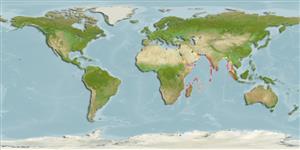Classification / Names
Common names from other countries
Main reference
Size / Weight / Age
Max length : 90.0 cm TL male/unsexed; (Ref. 3198); common length : 35.0 cm TL male/unsexed; (Ref. 5450); max. published weight: 3.2 kg (Ref. 3670); max. reported age: 14 years (Ref. 3627)
Length at first maturity
Lm ?, range 20 - 22 cm
Environment
Marine; freshwater; brackish; demersal; oceanodromous (Ref. 51243); depth range ? - 50 m (Ref. 86942)
Climate / Range
Tropical, preferred 26°C (Ref. 107945); 30°N - 35°S, 22°E - 103°E
Distribution
Indian Ocean, South Africa, Mozambique, the Red Sea, Persian Gulf, India, Phuket (Andaman Sea, specimen lost), and Malaysia (Penang Island and Langkawi Island, near Singapore). Western Pacific specimens recorded as A. berda refer to Acanthopagrus pacificus (Ref. 86288).
Countries | FAO areas | Ecosystems | Occurrences | Introductions
Short description
Dorsal
spines
(total): 11 - 12;
Dorsal
soft rays
(total): 10-12;
Anal
spines: 3;
Anal
soft rays: 8 - 9. This species is distinguished from all its congeners by the following characters: scale rows between fifth dorsal-fin spine base and lateral line 3.5; front edge of dorsal scaly area on head slightly convex, with small scales (fewer than 20) anteriorly; pored lateral-line scales 42-44; second anal-fin spine (2AS) longer than third anal-fin spine (3AS), 2AS/3AS ratio 1.23-1.50 (mean 1.36); strongly curved concavity on ventral edge of first two infraorbitals above rear end of maxilla, particularly obvious in specimens more than 13 cm SL; scales on preopercle flange absent; anal-fin membrane dark; molariform teeth strongly developed along both jaws, teeth rows strongly curved laterally at rear of lower jaw (Ref. 83673).
IUCN Red List Status (Ref. 115185)
Threat to humans
Harmless
Human uses
Fisheries: commercial; gamefish: yes
More information
ReferencesAquacultureAquaculture profileStrainsGeneticsAllele frequenciesHeritabilityDiseasesProcessingMass conversion
Tools
Special reports
Download XML
Internet sources
Estimates of some properties based on models
Phylogenetic diversity index
PD50 = 0.5000 many relatives (e.g. carps) 0.5 - 2.0 few relatives (e.g. lungfishes)
Trophic Level
3.5 ±0.42 se; Based on food items.
Resilience
Medium, minimum population doubling time 1.4 - 4.4 years (K=0.28-0.38; tmax=14; tm=1)
Vulnerability
Moderate vulnerability (42 of 100)
Price category
